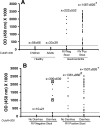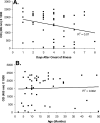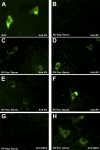Rotavirus antigenemia in children is associated with viremia
- PMID: 17439294
- PMCID: PMC1852122
- DOI: 10.1371/journal.pmed.0040121
Rotavirus antigenemia in children is associated with viremia
Abstract
Background: Antigenemia is commonly detected in rotavirus-infected children. Although rotavirus RNA has been detected in serum, definitive proof of rotavirus viremia has not been shown. We aimed to analyze a defined patient population to determine if infectious virus could be detected in sera from children with rotavirus antigenemia.
Methods and findings: Serum samples obtained upon hospitalization from children with gastroenteritis (57 stool rotavirus-positive and 41 rotavirus-negative), children with diagnosed bronchiolitis of known (n = 58) or unknown (n = 17) viral etiology, children with noninfectious, nonchronic conditions (n = 17), and healthy adults (n = 28) were tested for rotavirus antigen by enzyme immunoassay (EIA). Results of serum antigen testing were assessed for association with clinical and immunological attributes of the children. Rotavirus antigenemia was detected in 90% (51/57) of children with rotavirus-positive stools, in 89% (8/9) of children without diarrhea but with rotavirus-positive stools, in 12% (2/17) of children with bronchiolitis of unknown etiology without gastroenteritis, and in 12% (5/41) of children with gastroenteritis but with rotavirus-negative stools. Antigenemia was not detected in sera from children with noninfectious nonchronic conditions, children with bronchiolitis of known etiology and no gastroenteritis, or healthy adults. Neither age nor timing of serum collection within eight days after onset of gastroenteritis significantly affected levels of antigenemia, and there was no correlation between antigenemia and viral genotype. However, there was a negative correlation between serum rotavirus antigen and acute rotavirus-specific serum IgA (r = -0.44, p = 0.025) and IgG (r = -0.40, p = 0.01) titers. We examined 11 antigen-positive and nine antigen-negative sera for infectious virus after three blind serial passages in HT-29 cells using immunofluorescence staining for rotavirus structural and nonstructural proteins. Infectious virus was detected in 11/11 (100%) sera from serum antigen-positive children and in two out of nine (22%) sera samples from antigen-negative children (p = 0.002).
Conclusions: Most children infected with rotavirus are viremic. The presence of viremia is directly related to the detection of antigenemia and is independent of the presence of diarrhea. Antigenemia load is inversely related to the titer of antirotavirus antibody in the serum. The finding of infectious rotavirus in the blood suggests extraintestinal involvement in rotavirus pathogenesis; however, the impact of rotavirus viremia on clinical manifestations of infection is unknown.
Conflict of interest statement
Figures



Comment in
-
Rotavirus infection: a systemic illness?PLoS Med. 2007 Apr;4(4):e117. doi: 10.1371/journal.pmed.0040117. PLoS Med. 2007. PMID: 17439293 Free PMC article.
References
-
- Glass RI, Parashar UD, Bresee JS, Turcios R, Fischer TK, et al. Rotavirus vaccines: Current prospects and future challenges. Lancet. 2006;368:323–332. - PubMed
-
- Tucker AW, Haddix AC, Bresee JS, Holman RC, Parashar UD, et al. Cost-effectiveness analysis of a rotavirus immunization program for the United States. JAMA. 1998;279:1371–1376. - PubMed
-
- Gilger MA, Matson DO, Conner ME, Rosenblatt HM, Finegold MJ, et al. Extraintestinal rotavirus infections in children with immunodeficiency. J Pediatr. 1992;120:912–917. - PubMed
-
- Santosham M, Yolken RH, Quiroz E, Dillman L, Oro G, et al. Detection of rotavirus in respiratory secretions of children with pneumonia. J Pediatr. 1983;103:583–585. - PubMed
-
- Ruzicka T, Rosendahl C, Braun-Falco O. A probable case of rotavirus exanthem. Arch Dermatol. 1985;121:253–254. - PubMed
Publication types
MeSH terms
Substances
Grants and funding
- N01-AI45252/AI/NIAID NIH HHS/United States
- R01 AI024998/AI/NIAID NIH HHS/United States
- DK030144/DK/NIDDK NIH HHS/United States
- P30 DK056338/DK/NIDDK NIH HHS/United States
- F32 AI010604/AI/NIAID NIH HHS/United States
- AI24998/AI/NIAID NIH HHS/United States
- R01 DK030144/DK/NIDDK NIH HHS/United States
- R01 AI145871/AI/NIAID NIH HHS/United States
- AI145871/AI/NIAID NIH HHS/United States
- R21 AI024998/AI/NIAID NIH HHS/United States
- R56 AI145871/AI/NIAID NIH HHS/United States
- N01 AI030039/AI/NIAID NIH HHS/United States
- DK56338/DK/NIDDK NIH HHS/United States
- N01-AI30039/AI/NIAID NIH HHS/United States
- AI10604/AI/NIAID NIH HHS/United States
- N01-AI452252/AI/NIAID NIH HHS/United States
- R56 DK030144/DK/NIDDK NIH HHS/United States
LinkOut - more resources
Full Text Sources
Medical
Miscellaneous

